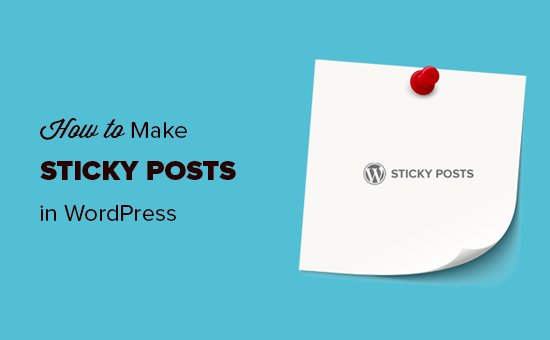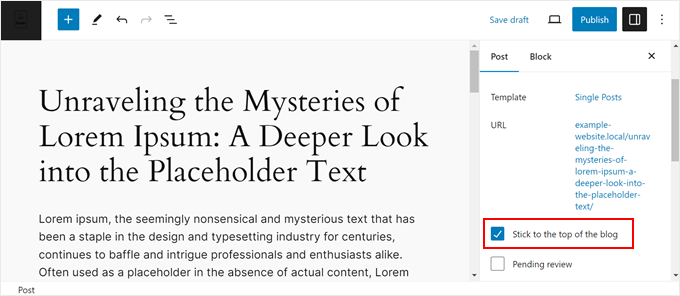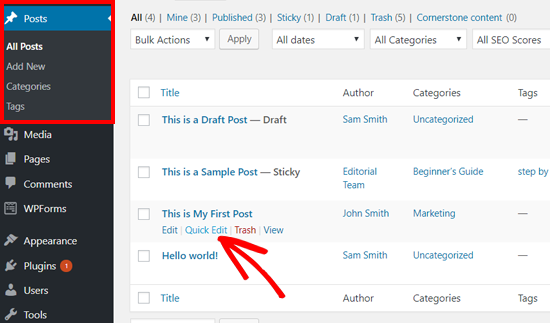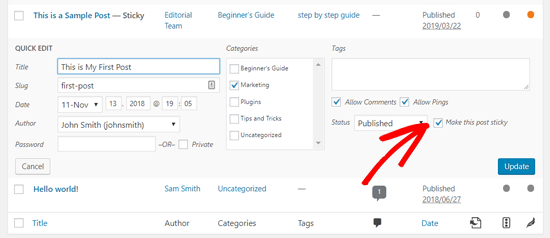Ever wanted to showcase an important article on your WordPress site, keeping it front and center for all visitors to see? Sticky posts are the solution to this problem.
We’ve used sticky posts countless times in our blogging projects to highlight everything from major announcements to comprehensive guides. It’s an easy way to draw attention to important content without relying on complex plugins or code changes.
If you want to learn more about using sticky posts, then keep reading. This guide will walk you through exactly what they are, when to use them, and how to use them step-by-step.

What Is a Sticky Post in WordPress?
A sticky post is a post that sticks to the top of your WordPress blog page. Unlike your regular posts, it stays on your blog’s front page until you remove its sticky option.
By default, WordPress shows your newest posts first. As you add more content, your older posts go down and eventually move to the archives.
This means that visitors are less likely to find that blog post unless they land on it in the search results or go looking through all the posts on your WordPress website.
But what if you wanted to show your pillar articles on the front page for a longer time? That’s when the WordPress sticky posts feature comes in handy.
When to Use a WordPress Sticky Post
Throughout our time using sticky posts, we’ve discovered that they can significantly increase engagement with important content. Sometimes doubling or even tripling views on key articles.
There are mainly two types of content that you may want to pin to your blog home page.
1. The Best Content (Pillar Articles) on Your Blog
Pillar articles are the most important content on your website. They include in-depth articles, comprehensive guides, and your most popular posts.
They are the best way to introduce new users to your blog, generate leads, and increase pageviews. You will want to highlight them across your website to make sure that new users can find these articles.
For example, you may have written a comprehensive blog post covering a specific topic in great detail. This article will be highly useful for your users, and you might want to stick it to the top.
2. Critical Content by Time-Relevancy
Another type of post that you may want to make sticky is time-relevant content like product updates, announcements, giveaways, and more.
If you have announced a major product update via your blog, then you will want your users to see it as soon as possible. Similarly, if you are running a giveaway for a month, then you will want everyone to see it before it expires.
Once the post’s time relevancy has expired, you can then replace it with new sticky posts.
Having said that, let’s see how to easily make your posts sticky in WordPress.
How to Make WordPress Posts Sticky (2 Ways)
WordPress comes with built-in functionality to stick any post to the front page, which means you won’t need to install any WordPress plugin for this.
All standard WordPress themes support this feature and will highlight the sticky post on the front page or the blog page.
First, you need to open the block editor and edit the post that you want to make sticky or create a new one.
On the post edit screen, you need to open the right-hand sidebar, where you will see your post settings.
In the ‘Summary’ settings, you just need to check the box next to ‘Stick to the top of the blog’.

Then, make sure to update or publish your post.
That’s it! Your post will now stick to your blog’s front page or homepage until you remove the check.
If you want to make an older post sticky, follow the same steps and just click the ‘Update’ button at the top.
You can also make older posts sticky with the Quick Edit feature.
Simply go to the Posts » All Posts page from your admin area and search for the respective post title. Next, you need to click the ‘Quick Edit’ option below it.

After that, you will see the quick edit options, including a sticky post checkbox at the bottom on the right side.
You need to check the box and click the ‘Update’ button below.

You can also apply this to your unpublished drafts to make them sticky once they are published.
For more tips and tricks related to sticky posts, you can read these guides:
- How to Add Sticky Posts in WordPress Custom Post Type Archives
- How to Exclude Sticky Posts from the Loop in WordPress
- How to Easily Re-Order Posts in WordPress (Step by Step)
More Ways to Show Off and Manage Your Best Content
Sticky posts are great for keeping important articles at the top of your blog. But there are even more ways to highlight your best content in WordPress. Here are some other tricks we’ve found useful:
- How to Display Popular Posts by Views in WordPress
- How to Redirect Users to a Random Post in WordPress
- How to Display Most Commented Posts in WordPress
- How to Display Related Posts in WordPress (Step by Step)
- How to Add Featured Posts in WordPress Sidebar
- How to List Future Upcoming Scheduled Posts in WordPress
- How to Expire Posts or Partial Post Content in WordPress
We hope this article helped you to learn how to make sticky posts in WordPress easily. You may also want to see our guide on how to efficiently manage post series in WordPress and our list of important pages that every WordPress blog should have.
If you liked this article, then please subscribe to our YouTube Channel for WordPress video tutorials. You can also find us on Twitter and Facebook.





Dennis Muthomi
After reading this, it got me thinking if a similar approach could be used to create a sticky sidebar table of contents for long blog posts.
As readers scroll through lengthy content, it would be great if the sidebar TOC would stay visible at all times.
Would it be possible??
WPBeginner Support
If you have a table of contents widget then we would recommend using the method from our article below to make it sticky
https://www.wpbeginner.com/plugins/how-to-create-a-sticky-floating-sidebar-widget-in-wordpress/
Admin
Dennis Muthomi
Thank you for the response and for linking me to that article!
I checked it out and it covers exactly what I was looking to do with keeping a sidebar table of contents visible while scrolling long posts.
THANK YOU SO MUCH
David Andrew Wiebe
Thanks for the tutorial! I had forgotten how to do this and needed a quick refresher. Worked like a charm.
WPBeginner Support
Glad our guide was helpful
Admin
Cheryl Downes
My (old) sticky post doesn’t show on the homepage or the category page.
I’m using the classic editor and followed the steps in the tutorial, but although it says it’s sticky, the behaviour of the post hasn’t changed?
WPBeginner Support
You may want to reach out to the support for your specific theme to see if your theme has a custom styling that is a bit odd.
Admin
Katia
Hi,
Thanks for this info. I am looking for a new way to create a sticky post on a category page, so not on the homepage. I used a plugin for this but I got notified from Wordfence that it hasn’t been updated in 3 years so I better look for another solution. Do you have any suggestion for this?
Thanks
Katia
WPBeginner Support
We would first recommend taking a look at our article here: https://www.wpbeginner.com/opinion/should-you-install-plugins-not-tested-with-your-wordpress-version/

Admin
Jubair Bin Iqbal
Thank you so much for your topic. This is so helpful for me.
WPBeginner Support
You’re welcome, glad our guide could help
Admin